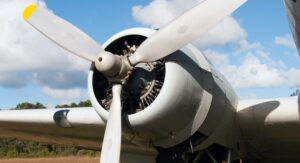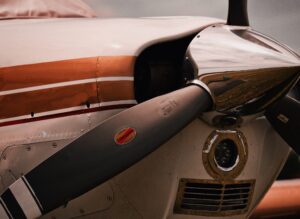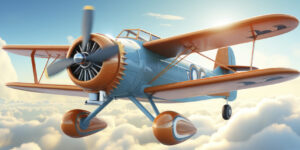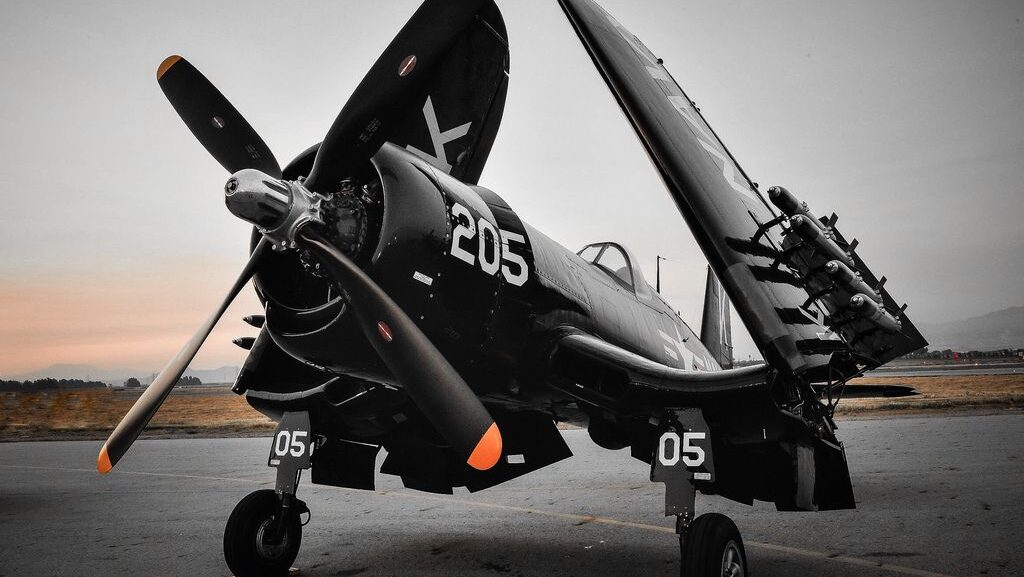The Vought Corsair Fighter Aircraft was a high-performance fighter, usable on both carriers and land. Its main mission was to destroy enemy aircraft. It was armed with bombs and rockets. The low-wing monoplane had a distinctive inverted gull shape, with a long fuselage extending ahead of its cockpit. The XF4U-1 made its first flight in May 1940. By the time the United States entered World War II, the design and concept for the F4U-1 were well underway. To speed up production, Goodyear and Brewster received contracts to make Corsairs, designated FG-1 and F3A-1, respectively.
Initially, the Corsair Fighter Aircraft had trouble landing on aircraft carriers, but the U.S. Marines and U.S. Navy shore-based squadrons used the aircraft. Advances in design and radar allowed carriers to use Corsairs in early 1944. The Royal Navy and the New Zealand Air Force also added the aircraft to their fleets. With improvements in altitude capabilities and engine modifications, the Corsair became one of the standout aircraft of World War II.
Origins of the Aircraft
The Corsair Fighter Aircraft was developed by Vought in the late 1930s because the US Navy needed a faster and more powerful carrier-based fighter. It first flew in 1940. Despite facing initial challenges, it soon became one of the deadliest aircraft of the war.

The Iconic Design – Bent Wings Explained
The Vought F4U Corsair is a legendary fighter aircraft known for its unique gull-wing design and exceptional performance during World War II. Its distinctive wing shape, which was a compromise in design, enabled a large propeller and short landing gear, which were essential for carrier operations. The Corsair’s powerful engines and armament made it a formidable foe in the Pacific.
Power Under the Hood – The Engine
The Vought F4U Corsair is a legendary fighter aircraft known for its unique gull-wing design and exceptional performance during World War II. Its distinctive wing shape, which was a compromise in design, enabled a large propeller and short landing gear, which were essential for carrier operations. The Corsair’s powerful engines and armament made it a formidable foe in the Pacific.
Armament and Firepower
The Corsair was not only fast, but also heavily armed. Most versions were armed with six .50 caliber M2 Browning machine guns. Later models could also carry rockets and bombs, making the Corsair a versatile fighter-bomber. The F4U Corsair fighter had a robust armament package, primarily consisting of six .50 caliber (12.7 mm) M2 Browning machine guns. It could also carry two 1,000-pound bombs, significantly increasing its ground attack capability.
Armament Details:
Primary Guns: Six .50 caliber (12.7 mm) M2 Browning machine guns.
Bomb Load: Could carry two 1,000-pound bombs, adding a ground attack dimension to its firepower.
Speed, Agility and Performance
The Corsair fighter aircraft was the fastest fighter aircraft with a maximum speed of about 450 mph, outpacing many of its competitors. Its agility made it a nightmare for Japanese Zero pilots. Pilots often said the Corsair’s speed gave it an edge in air-to-air combat, especially against the Japanese Zero
Navy testing and issue to the US Marine Corps
The US Navy received its first F4U-1 aircraft on July 31, 1942, however, bringing it into service was challenging. The framed “birdcage” style canopy provided poor visibility for taxiing. The Corsair Fighter Aircraft’s long “hose nose” and upward tilted position made it difficult to see straight ahead. The powerful torque of the twin Wasp engines also complicated steering for inexperienced pilots in emergencies. Early Navy pilots nicknamed the F4U the “hog“, “hosenoses” or “bent-wing widow maker”.
Carrier qualification tests on the training carrier USS Wolverine and the escort carriers USS Core and USS Charger in 1942 showed that despite visibility problems and sensitive controls, the Corsair was “…an excellent carrier type and very easy to land on. It is no different from any other airplane.” Two Navy units, VF-12 (October 1942) and later VF-17 (April 1943), were equipped with the F4U. By April 1943, VF-12 had successfully completed deck landing qualifications.

Battle Success in the Pacific Theater
the Corsair Fighter aircraft was successful in the Pacific because of its powerful engines, speed, versatility, and flexible design, even with Initial challenges. Its influence on air-to-air combat and ground attack operations, along with its psychological effect on the enemy, played a major role in the Allied victory.
The Corsair vs. Other Fighters of Its Era
The Corsair fighter aircraft was a powerful and robust fighter, a formidable competitor in its day. Compared to the Japanese Zero, the Corsair fighter aircraft was faster, more robust, and better armed. It often outperformed contemporary aircraft such as the F6F Hellcat in speed and firepower, especially in roles such as ground attack. Although the Hellcat was initially preferred for carrier operations due to its ease of operation, the Corsair’s superior performance eventually led to the Corsair being used primarily to intercept Japanese kamikaze attacks. Against the P-51 Mustang, the Corsair held its own, especially at sea where the Mustang could not operate while the Corsair was more versatile, excelling in both air-to-air and ground attack, especially at medium to low altitudes.
Carrier Operations – Challenges and Triumphs
Initially, the Corsair fighter aircraft had trouble landing on carriers due to its long nose and short deck-span, causing visibility problems. Many believed it was too dangerous for carriers. However, with training and modifications, it eventually became a reliable naval fighter aircraft.
Pilots’ experiences and stories
Many pilots found the Corsair fighter scary at first, but once they mastered it, it became their favorite aircraft. Stories tell of Corsair pilots flying despite being riddled with bullets on missions, and pilots who flew the Corsair fighter often described it as a powerful and challenging aircraft.
Corsair in the Korean War
The Corsair was a key player in the Korean War serving as a fighter-bomber for both the U.S. Navy and Marine Corps
It fought again in the Korean War, this time as a ground attack aircraft. Its ability to carry rockets and bombs made it perfect for supporting troops on the battlefield.

Why the Corsair fighter continues to inspire today
The Corsair is not just an aircraft—it is a symbol of innovation, courage and resilience.
The Corsair fighter aircraft continues to inspire today because of its iconic design, its impressive performance during World War II, and its enduring legacy in naval aviation.
FAQs
Why was the Corsair Fighter Aircraft called “Whistling Death”?
Because of the unique sound it made when diving, enemy soldiers and pilots gave it the nickname “Whistling Death.”
How fast could the Corsair Fighter Aircraft fly?
The Corsair had a top speed of nearly 450 mph, making it one of the fastest fighters of its time.
What made the Corsair’s wings bent?
The inverted gull wing design allowed the plane to fit a huge propeller while keeping the landing gear shorter and sturdier.
Did the Corsair only serve in World War II?
No, the Corsair also served in the Korean War, mainly in a ground-attack role.
Can you still see Corsair Fighter Aircraft today?
Yes! Many restored Corsairs fly at airshows worldwide, serving as living reminders of aviation history.

